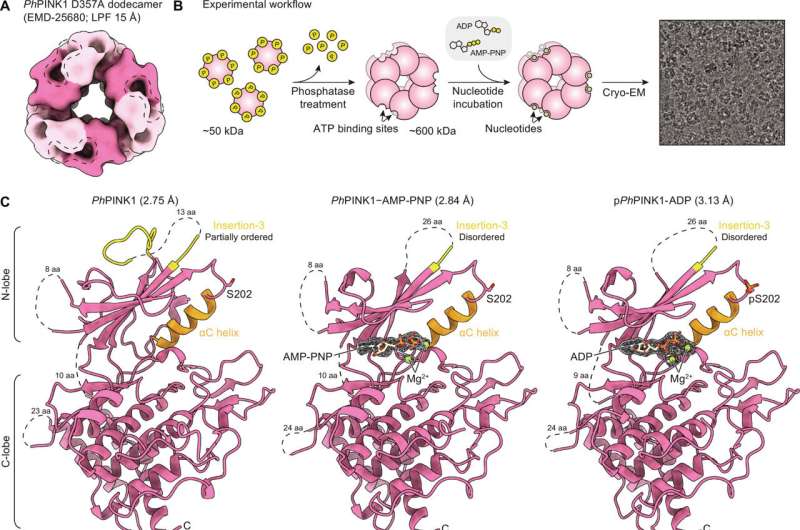This article has been reviewed according to Science X's editorial process and policies. Editors have highlighted the following attributes while ensuring the content's credibility:
fact-checked
peer-reviewed publication
trusted source
proofread
Research overturns previous findings on potential Parkinson's disease target

A new study has found a molecule hailed as a potential drug candidate for Parkinson's disease is no longer an effective therapeutic option. The WEHI-led research has debunked over 10 years of research that suggested a specific 'activator molecule' could be used to enhance the activity of a protein linked to early-onset Parkinson's disease, PINK1.
The paper is published in the journal Science Advances.
Visualizing PINK1 at an atomic level, the study has transformed our understanding of how PINK1 interacts with natural chemicals but cannot interact with larger drug candidates previously reported to bind similarly. The work will inform efforts to find treatments for the disease, which currently has no cure.
Mutations in the PINK1 protein have been linked to early-onset Parkinson's disease (EOPD), a progressive neurodegenerative disease that has no drug to slow, stop or prevent its progression.
It is estimated that around 220,000 people suffer from Parkinson's disease in Australia alone, with 38 people diagnosed daily.
Although EOPD is thought to make up about 10% of the total number of people with Parkinson's disease, researchers believe that by focusing on EOPD and the genetic mutations associated with the disease, this will lead to quicker drug therapies to help those living with Parkinson's disease.
PINK1: a better understanding of Parkinson's
PINK1 is a mitochondrial protein that supports cell survival. When it is mutated, it can no longer function properly.
Mitochondria are often described as the powerhouses of cells because they produce adenosine triphosphate (ATP), the source of energy at a cellular level.
When mitochondria are damaged and need disposing to keep cells healthy, they are first tagged by PINK1.
Building a better understanding into the pathways of how damaged mitochondria are processed is crucial to developing a drug therapy for Parkinson's disease. Research into PINK1 is one such pathway.
In the new study, researchers developed a method of imaging PINK1 at an atomic level using high powered microscopy. The team then tracked how the protein switches into its active form when ATP, or its "copycat" molecule KTP, are added.
KTP was reported over a decade ago to enhance PINK1 activity in cells and had represented a promising strategy for early onset Parkinson's disease treatment.
But the research team, led by Dr. Zhong Yan Gan (now at the Laboratory of Molecular Biology, Cambridge), Dr. Sylvie Callegari and Professor David Komander discovered that KTP could not bind to the protein as previously thought.
Dr. Callegari is a Senior Researcher in the Komander Lab whose work contributes to the progress being made by WEHI's Parkinson's Disease Research Center.
"While we don't fully understand how PINK1 is stabilized on mitochondria yet, we know that PINK1 tagging is the first step in identifying mitochondrial damage," she said.
A critical step in this process is the activation of the signal-generating ability of PINK1, as soon as it has accumulated on mitochondria.
This requires an additional ingredient, the molecule ATP, which binds to and is used by PINK1 to generate the damage signal.
Advances in technology
The team developed a method of "clustering PINK1 proteins together" so they could stabilize them enough to take high resolution snapshots using cryo-electron microscopy, which has exponentially advanced in the imaging capabilities it provides over the last decade.
Cryo-electron microscopy is an advanced imaging technique used to reveal the 3D structure of biological molecules at near-atomic resolution.
The sample is rapidly frozen to temperatures below -150 °C and then beams of electrons are passed through the sample from various angles to produce 2D images which are then used to reconstruct a 3D model.
"The real key to all of these findings has been our ability to visualize PINK1 at an atomic level and observe the structural changes that happen when these molecules bind," said Dr. Callegari, who won the poster prize for this work at a recent Keystone Symposium.
The atomic-level visualization enabled the team to see how PINK1 interacts with molecules such as ATP or KTP, a synthesized, larger copy of ATP.
While researchers have long believed KTP can enhance PINK1 activity, cryo-EM technology enabled a closer inspection. To their surprise, the researchers found that KTP cannot bind to or be used by PINK1 due to its size.
"We did not expect that result, but it's clear from our visualization that KTP is just too big to work," Dr. Callegari said.
What it means for Parkinson's disease
While this finding rules out the use of KTP or its precursors therapeutically in Parkinson's disease patients, it generates new tools to study PINK1 action through non-natural signal inducers such as KTP.
"This work highlights the importance of using the latest high-powered imaging to visualize in detail how therapeutic compounds work," Dr. Callegari said.
"The strategy will now be used to explore novel compounds than can activate or stabilize PINK1, hopefully leading to new treatments for Parkinson's disease."
More information: Zhong Yan Gan et al, Interaction of PINK1 with nucleotides and kinetin, Science Advances (2024). DOI: 10.1126/sciadv.adj7408




















